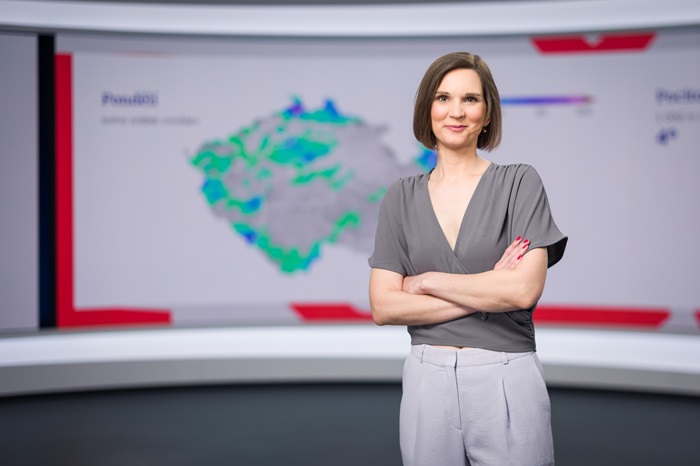The success of TV weather programmes is linked to technological innovations in the field and also to the experience of the meteorologists who prepare the programmes. Although viewers may not realise it, each television station works with different input sources and processes the data in its own way.
"At Nova, we calculate our own numerical model, which works with a resolution of 2x2 km and all forecasting is based on it. The model works with the meteorological elements we need and thanks to this we can predict the development hour by hour for several days ahead,"
meteorologist Dagmar Honsová, whose company supplies TV Nova's forecasts and also hosts the Weather session, describes in an interview with MediaGuru.cz. The company has been developing the numerical model for the last twenty years and is the source of all the forecasts that TV Nova uses in its broadcasts. "It is very important that we can work with this model because we can stand behind the forecasts," he says.
Global models that could also be used have a higher resolution and do not know the relief of the Czech Republic, according to Dagmar Honsová. "Every European country has its own numerical model. The best known is the Czech Aladin or Medard, but we wanted to use our model," she explains further. "Other people at TV Nova can then get into the interface where we calculate the weather forecasts and quickly prepare the forecasts in graphical form. So we can add appropriate icons or show the probability of rainfall or other elements very quickly," he adds. The forecasts on TV Nova also differ from other forecasts in the Czech Republic in that they do not give the air temperature two metres above the ground in a shaded weather station, as is usual, but give the sensible temperature, i.e. recalculated according to the influences that can affect it, such as wind or humidity.
The first weather forecast is included by Nova in its morning programme Snídaně s Novou. There are also live sessions at midday, afternoon (17:00) and evening (20:20). The numerical model is programmed to be recalculated four times a day to keep the forecasts as up-to-date as possible.
"One hundred percent success cannot be achieved. The numerical model has a lot of mathematical equations in it, which can be adjusted based on altitude, as we have found that altitude plays a major role in the Czech Republic. It works with the freshest data from weather stations, but if something happens in the atmosphere in the afternoon and the model uses data received at 10:00 a.m., there is nothing that can be done about it,"
says Dagmar Honsová. Therefore, it is necessary to take into account a certain deviation and treat the presented outlook as a forecast. "We know very well what is happening on the ground. Thanks to the balloon probe, we also know what is happening up to 5-6 km above the ground, but what is happening 6-12 km above the ground, we have less data," she explains.
Computing forecast accuracy, or deterministic forecasting, is key to making further predictions. For one day ahead, the forecast success rate is 95%, but it also depends on what the meteorological elements and seasons are. In April, for example, the forecast success rate tends to be lower because the situation changes rapidly in the upper atmosphere and the weather is less stable.
Recently, Nova has been increasingly including the so-called nowcasting weather forecast, which is a forecast for a few tens of minutes in advance. "Weather forecasts used to be pre-cast, but now they are broadcast live. So we can afford to change them just a few minutes before the broadcast. Nowcasting weather forecasts were not very familiar to people in the Czech Republic, but thanks to the Storm Hunters, an amateur meteorological group, they have been a great success," he says. Their success rate may be increased in the future by a new satellite in orbit, which currently updates the situation every 15 minutes, in the coming months it should be only ten minutes, and prospectively in the next few years at an interval of 2.5 minutes.
Dagmar Honsová gets her first idea of what the morning weather forecast will sound like early in the morning at 4:00 a.m., when she starts monitoring the various meteorological elements. By 9:00 she already knows the outline of the forecast for the current day. On the basis of this, graphics are prepared and the specific shape of the session begins to take shape. This can vary from time to time. "For example, we don't use 24-hour models every day, there is no room for it, but we use it in cases where the forecast may seem harder to believe. That's why I include a demonstration of hour-by-hour development, so that viewers believe me," he says. So the team builds the entire forecast itself. "Within a short time, we have to deliver a beneficial and meteorologically correct forecast to the audience in a way that they will enjoy. That's terribly challenging. If I didn't see all the model outputs and elements, I would never get in front of the camera because I wouldn't know what to say. I can't learn in advance, I have to interpret what I've seen in retrospect," she says.
Weather sessions regularly rank among the most watched shows on television. The most watched is the evening session, whose viewership on TV Nova exceeds the one million mark for viewers over 15 years old.
Source: mediaguru.cz

